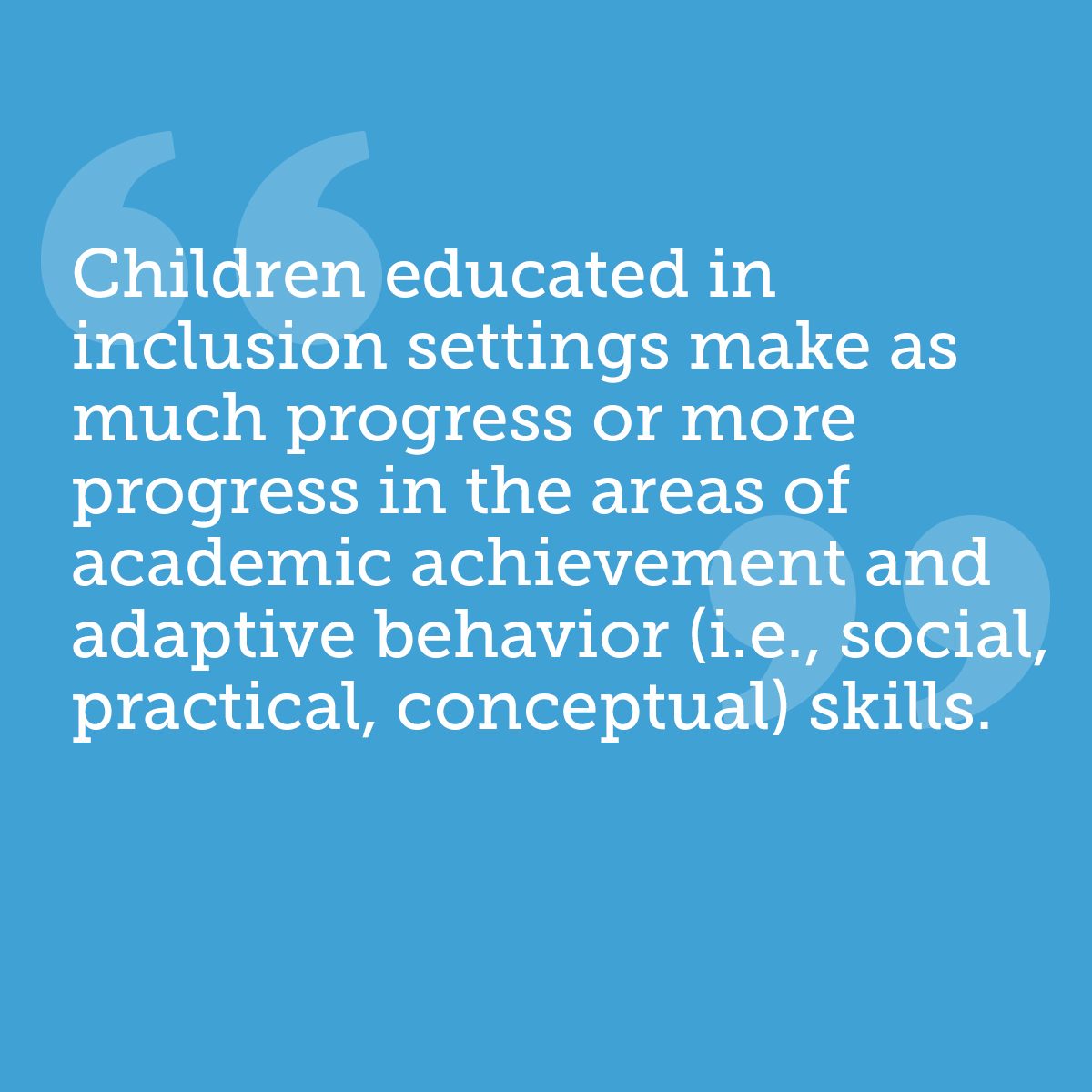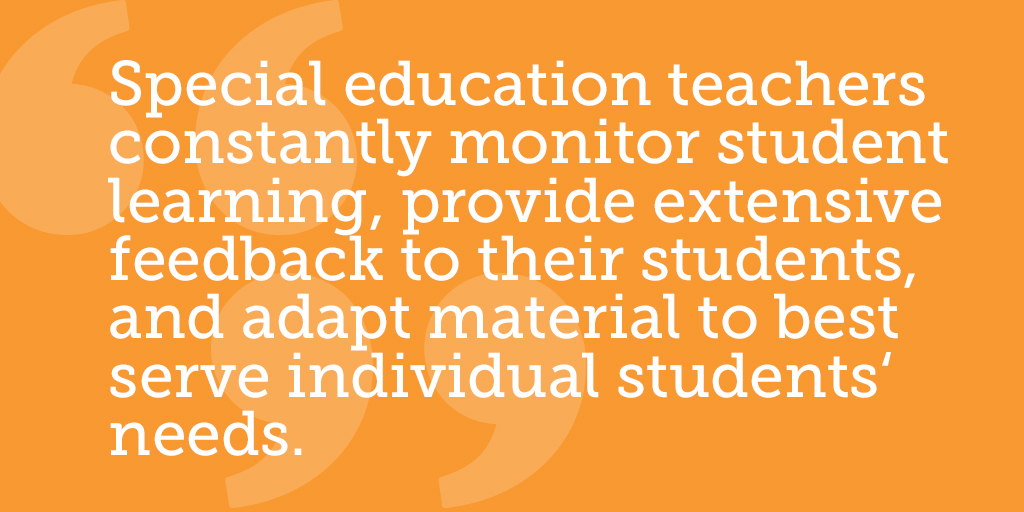
What kind of support is helpful for students with different abilities and needs?
Special education is instruction and programming specifically designed for students who have special learning needs and require additional support, accommodations, or modifications that they would not receive as part of the general education curriculum. Around 13% of all public school students in the U.S. receive special educational services.[i] Every student who has been identified as eligible to receive special education services receives an Individualized Education Plan (IEP), which is a legally binding document containing the special accommodations and services the school will provide that child to best enhance their individual education.[ii] The IEP also contains a statement of measurable annual education and functional goals.
There is a wide range of reasons why students may have special educational needs — learning disabilities/differences, physical disabilities, language disorders, or emotional/behavioral disorders. Depending on the individual needs of each student, they may benefit from accommodations, where the student learns the same material as their peers but with different methods, or modifications, where the material is changed. They also may qualify for services such as speech and language therapy, occupational therapy, or counseling.
The sections below highlight key findings from the research on the differences and abilities of special education students as well as effective accommodations and interventions.

Several studies have found that children with special needs who are educated in inclusion settings make as much progress or more progress in their academic achievement [iv, v, vi] and adaptive behavior (i.e., social, practical, conceptual) skills as those educated separately.[vii] Research has also shown that the inclusion of students with special needs in general education classrooms has either a neutral or a positive impact on peers without special education needs.[viii] Federal legislation in the United States guarantees students with disabilities a free and appropriate education in the least restrictive environment possible, which means that students with special educational needs will be educated in the general education curriculum to the fullest extent possible, and will only be placed in a more restrictive environment, such as a self-contained special education class, when their needs cannot be met in the general education setting.[iii]
Self-determination is a person’s ability to direct their own life and make their own choices. It is particularly important for students with learning differences, who are often given less autonomy to control their education. Student self-determination has been linked to greater academic productivity and improvements in certain classroom behaviors and academic skills, such as the ability to stay on task and complete assignments.[ix] It also has an impact beyond school, as self-determination is associated with higher quality of life, employment, and independent living among adults with disabilities.[x] While self-determination is related to an individual’s intellectual and social abilities, it is also a product of their environment and how much autonomy and choice they are granted.[xi] Self-directed individualized education program (IEP) interventions have been shown to help special education students be more involved in the development of the plans that guide their
education and transition into adult life.[xii] Other self-determination interventions help build self-directed learning skills, such as goal setting, decision making, and prioritization.[xiii]
Response to intervention (RTI) models are service delivery systems designed to prevent, identify, and remediate academic difficulties by focusing on a student’s response to an intervention. RTI models can be implemented in a variety of ways, but they are always multi-tiered, with the intervention intensity increasing with each level.[xiv] A three tier model is frequently used. Tier 1 consists of universal screening to identify any students at risk for developing academic problems so their progress can be monitored. Children who do not progress as expected move to Tier 2, where they receive additional instruction in small groups of students. Those students who need additional help proceed to Tier 3, where they often are provided with additional individualized intervention. Many RTI models have been successfully implemented in school districts, often resulting in an increase in academic achievement as well as a decrease in the number of referrals to special education.[xv]
Each student with special educational needs should be assessed to determine what types of test accommodations will benefit them. Often, a combination of several accommodations are used.[xvi] Some common test accommodations include allowing extra time to take tests, oral administration of tests, and computerized administration of tests.[xvii] Several studies have found that students’ academic achievement scores positively benefit from test accommodations, especially extra time [xviii] and oral presentation [xix] accommodations.
 Special education teachers possess a wide array of complex skills. In addition to content knowledge (e.g., knowledge of reading or math), they also possess excellent classroom management skills, and are able to continuously engage their students.[xxi] Special education teachers must also understand how to identify learning needs and best teach students with individual learning differences. To do this, special education teachers constantly monitor student learning, provide extensive feedback to their students, and adapt material and methods to best serve individual students’ needs.[xx]
Special education teachers possess a wide array of complex skills. In addition to content knowledge (e.g., knowledge of reading or math), they also possess excellent classroom management skills, and are able to continuously engage their students.[xxi] Special education teachers must also understand how to identify learning needs and best teach students with individual learning differences. To do this, special education teachers constantly monitor student learning, provide extensive feedback to their students, and adapt material and methods to best serve individual students’ needs.[xx]
Explore Special Education on the Visualization.
Citations
[i] NCES 2015 https://nces.ed.gov/programs/coe/indicator_cgg.asp
[ii] https://www2.ed.gov/parents/needs/speced/iepguide/index.html
[iii] Cortiella, C., & Horowitz, S. H. (2014). The state of learning disabilities: Facts, trends and emerging issues. New York: National Center for Learning Disabilities.
[iv] Laws G., Byrne A. & Buckley S. (2000) Language and memory development in children with Down syndrome at mainstream and special schools: a comparison. Educational Psychology 20, 447–57.
[v] Turner, S., Alborz, A., & Gayle, V. (2008). Predictors of academic attainments of young people with Down’s syndrome. Journal of Intellectual Disability Research, 52(5), 380-392.
[vi] Rafferty, Y., Piscitelli, V., & Boettcher, C. (2003). The impact of inclusion on language development and social competence among preschoolers with disabilities. Exceptional Children, 69, 467–479.
[vii] Dessemontet, R. S., Bless, G., & Morin, D. (2012). Effects of inclusion on the academic achievement and adaptive behaviour of children with intellectual disabilities. Journal of Intellectual Disability Research, 56(6), 579-587.
[viii] Kalambouka, A., Farrell, P., Dyson, A., & Kaplan, I. (2007). The impact of placing pupils with special educational needs in mainstream schools on the achievement of their peers. Educational Research, 49(4), 365-382.
[ix] Konrad, M., Fowler, C. H., Walker, A. R., Test, D. W., & Wood, W. M. (2007). Effects of self-determination interventions on the academic skills of students with learning disabilities. Learning Disability Quarterly, 30(2): 89-113.
[x] Wehmeyer, M. L., & Palmer, S. B. (2003). Adult outcomes for students with cognitive disabilities three-years after high school: The impact of self-determination. Education and training in developmental disabilities, 131-144.
[xi] Nota, L., Ferrari, L., Soresi, S., & Wehmeyer, M.L. (2007). Self determination, social abilities, and the quality of life of people with intellectual disabilities. Journal of Intellectual Disability Research, 51: 850-865.
Shogren, K. A., Wehmeyer, M. L., Palmer, S. B., Soukup, J. H., Little, T. D., Garner, N. & Lawrence, M. (2007). Examining individual and ecological predictors of the self-determination of students with disabilities. Exceptional Children, 73: 488-509.
[xii] Martin, J. E., Van Dycke, J. L., Christensen, W. R., Greene, B. A., Gardner, J. E., & Lovett, D. L. (2006). Increasing student participation in IEP meetings: Establishing the self-directed IEP as an evidenced-based practice. Exceptional Children, 72(3): 299-316.
Lee, S. H., Wehmeyer, M. L., Palmer, S. B., Soukup, J. H., & Little, T. D. (2008). Self-determination and access to the general education curriculum. The Journal of Special Education, 42(2): 91-107.
[xiii] Chambers, C.R., Wehmeyer, M.L., Saito, Y., Lida, K.M., Lee, Y., & Singh, V. (2007). Self-determination: What do we know? Where do we go? Exceptionality, 15: 3-15.
[xiv] Vaughn SR, Wanzek J, Woodruff AL, Linan-Thompson S. A three-tier model for preventing reading difficulties and early identification of students with reading disabilities. In: Haager DH, Vaughn S, Klingner JK, editors. Validated reading practices for three tiers of intervention. Baltimore, MD: Brookes; 2006. pp. 11–28.
[xv] VanDerHeyden AM, Witt JC, Gilbertson D. A multiyear evaluation of the effects of a response to intervention (RTI) model on identification of children for special education. Journal of School Psychology. 2007;45:225–256.
[xvi] Johnstone, C. J., Altman, J., Thurlow, M. L., & Thompson, S. J. (2006). A Summary of Research on the Effects of Test Accommodations: 2002 through 2004. Technical Report 45. National Center on Educational Outcomes, University of Minnesota.
[xvii] Zenisky, A. L., & Sireci, S. G. (2007). A Summary of the Research on the Effects of Test Accommodations: 2005-2006. Technical Report 47. National Center on Educational Outcomes, University of Minnesota]
[xviii] Mandinach, E. B., Bridgeman, B., Cahalan-Laitusis, C., & Trapani, C. (2005). The impact of extended time on SAT test performance. Research Report No 2005-8. New York, NY: The College Board.
[xix] Fletcher, J. M., Francis, D. J., Boudousquie, A., Copeland, K., Young, V., Kalinowski, S., & Vaughn, S. (2006). Effects of accommodations on highstakes testing for students with reading disabilities. Exceptional Children, 72 (2), 136-150.
[xx] Stough, L. M., & Palmer, D. J. (2003). Special Thinking in Special Settings A Qualitative Study of Expert Special Educators. The Journal of Special Education, 36(4), 206-222.
[xxi] Brownell, M. T., Bishop, A. G., Gersten, R., Klingner, J. K., Penfield, R. D., Dimino, J., Haager, D, Menon, S., & Sindelar, P. T. (2009). The role of domain expertise in beginning special education teacher quality. Exceptional Children, 75(4), 391-411.